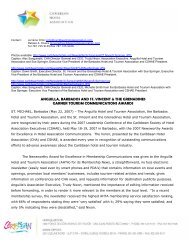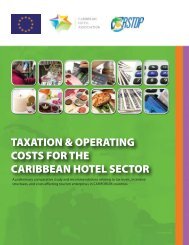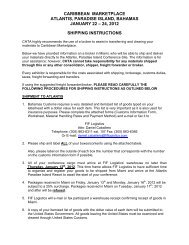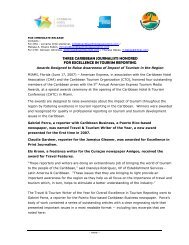Disaster Risk Management for Coastal Tourism - Caribbean Hotel ...
Disaster Risk Management for Coastal Tourism - Caribbean Hotel ...
Disaster Risk Management for Coastal Tourism - Caribbean Hotel ...
Create successful ePaper yourself
Turn your PDF publications into a flip-book with our unique Google optimized e-Paper software.
<strong>Disaster</strong> <strong>Risk</strong> <strong>Management</strong> For <strong>Coastal</strong> <strong>Tourism</strong> Destinations Responding To Climate Change<br />
A Practical Guide For Decision Makers<br />
Chapter 2 of the Handbook provides synthesized explanations of:<br />
<br />
The elevated risks and impacts of climate change on coastal areas;<br />
The peculiar characteristics of the global tourism industry that necessitate<br />
strategic and cross-sectoral planning and response actions.<br />
<br />
<br />
Climate change adaptation strategies and programs <strong>for</strong> coastal zones<br />
which are available to disaster managers and multi-sector stakeholder<br />
groups.<br />
The special needs and characteristics of small island developing states<br />
when combating climate induced-events.<br />
Chapter 3 provides an overview of disaster preparedness and management<br />
frameworks at international, regional and national levels and a description of UNEP’s<br />
10-step APELL process and its suitability <strong>for</strong> adoption in disaster risk reduction at<br />
coastal tourism communities.<br />
Having established this context, the Handbook addresses an important question:<br />
How should we prepare and enhance tourism destination integrity and resilience in<br />
the face of more frequent natural disasters and their related hazards? The answer<br />
lies in the deeper involvement of coastal tourism communities.<br />
Chapter 4 provides key guidance on how the community can identify and assess<br />
natural disaster risk at the coastal tourism destination. The approach promulgated<br />
here is a collaborative one with local disaster agencies and intended to be practical<br />
<br />
Chapter 5 guides users through the disaster preparedness plan <strong>for</strong>mulation stage<br />
and writing process, pointing out the role of the coordinating agencies and actors to<br />
ensure plan buy-in and approval.<br />
Chapter 6 focuses on plan implementation including drill and simulation exercises<br />
and rehearsing, pointing out the need <strong>for</strong> continuous review and evaluation,<br />
incorporating lessons learned from simulated disaster scenarios and including<br />
strategies <strong>for</strong> routine updating, public education and training of key implementation<br />
staff.<br />
<br />
mainstreaming risk reduction into the disaster and development planning process. It<br />
is important to have established milestones and targets to ensure that objectives are<br />
met and that continuous learning and knowledge are built into destination planning.<br />
This provides the best benchmark <strong>for</strong> achieving community and destination<br />
resilience.<br />
The authors encourage regular feedback and comment to ensure that this<br />
publication continues to evolve and be relevant to the needs of all users.<br />
18 | Introduction








